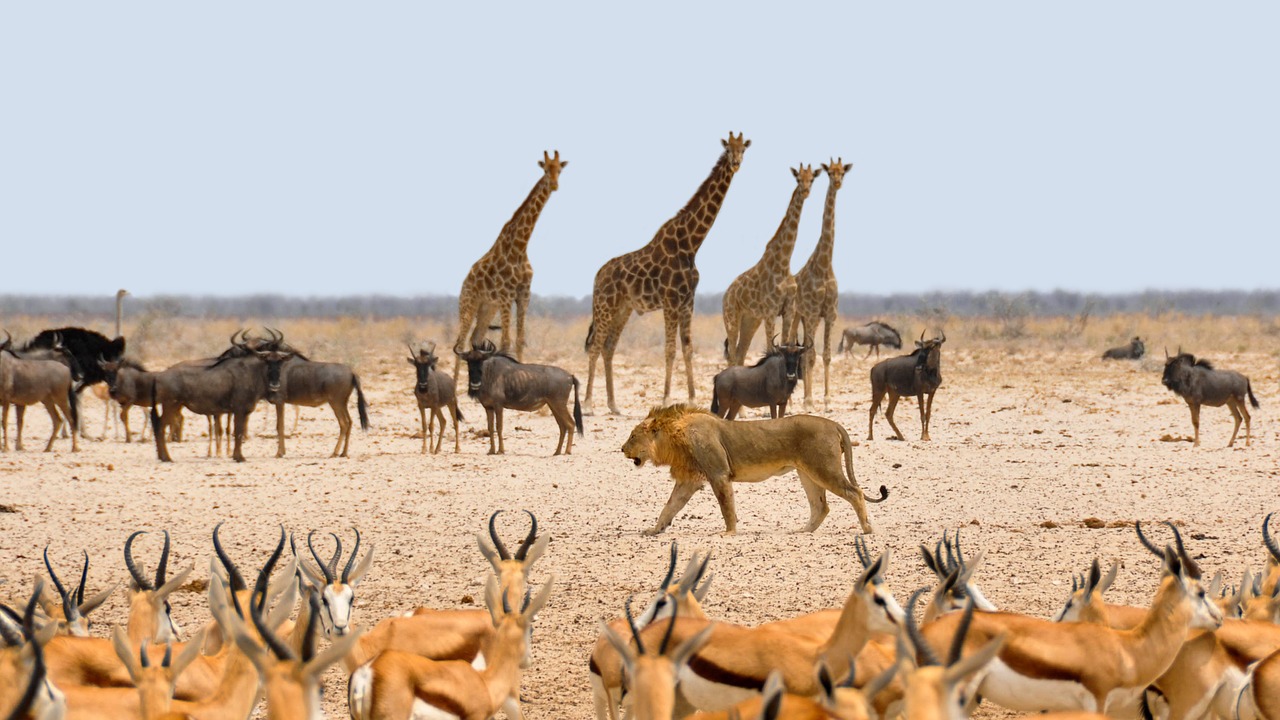Lions are the undeniable monarchs of the African wild and one of the most sought-after safari sightings. It’s thrilling to watch lions in Africa, and it’s a primal fascination.
Lions are the top predators in Africa, preying on enormous animals such as zebras, buffalos, giraffes, hippopotamuses, and even young elephants. It’s thrilling to see lionesses on the hunt, and their entourage of hyenas, jackals, and vultures is always fascinating. Lions, which are the same colour as the savannah they live on, are as much a part of the African landscape as flat-topped acacia trees and red, crumbly earth. Hearing their loud roars as they gather for hunting at dusk is a once-in-a-lifetime experience. Their calls are also a chilling reminder that they still own the wilderness.
Namibia, Namib Desert
Northern Namibia’s lions are among the most fascinating on the planet, thriving in a harsh environment with scant vegetation and prey. The lions that wander the Namib Desert have adapted admirably to this harsh habitat, earning them the moniker “desert-adapted” or “desert lions.” Because of their nomadic nature, seeing them is never guaranteed — your best option would be to visit the isolated Kaokoveld and Damaraland.
Botswana, Okavango Delta
Everyone knows that cats dislike water, but the lions of Duba Plains in the northern Okavango Delta have learned to flourish in it for good reason: the area’s nutritious grasses and persistent water make it ideal for buffalo. And lions adore buffalo.
Masai Mara National Reserve, Kenya
Lions are so abundant in Kenya’s Masai Mara that they once had their own BBC nature documentary series, Big Cat Diary. Every year around July, two million wildebeest cross the Mara River into the Masai Mara National Reserve to feast on fresh and succulent grass – all while being watched over by hungry lions. Not only is it a fantastic place to see lions in Africa all year, but the Mara’s flat, wide, and open plains are also ideal for cheetah – it’s a fantastic place to watch the world’s fastest land mammal chase down its prey
Serengeti National Park, Tanzania
The Serengeti-Mara ecosystem, which stretches from Tanzania’s stunning Serengeti to Kenya’s Maasai Mara, is home to one of the world’s largest populations of wild lions, estimated to number around 4,000. It also has Africa’s oldest lion research project, which has been running for over 50 years in the Serengeti National Park in Tanzania. Across the border in Kenya, the vast savannah plains of the Maasai Mara National Reserve provide an excellent opportunity to see large prides that have grown accustomed to the presence of the reserve’s few tourist vehicles.
Queen Elizabeth National Park, Uganda
Although lions can be seen lazing in the heat of the day all over Africa, there is no better place to see them than in Uganda’s Queen Elizabeth National Park on safari. The big cats take it a step further by sleeping within the branches of massive sycamore fig trees.
These lions, both young and old, are thought to rest in the branches to avoid being bitten by insects and to escape the heat. To spot these lions and appreciate their unique behavior, we recommend staying at Ishasha Wilderness Camp, which combines an authentic glamping experience with excellent game viewing.
Kruger National Park, South Africa
For those looking for a lion safari in South Africa, the great Kruger National Park has always been the go-to destination. Kruger National Park, which is the size of Wales, is home to over 1,600 lions, averaging five to six lions per 100km2. If you’re hoping to see a lion, our best advice is to head to the south of the park, which is thought to be the best for lion sightings due to a higher concentration of prey. The unfenced private reserves that border the Kruger National Park are also excellent places to spot lions in the Kruger area.
South Luangwa National Park, Zambia
The northerly area of the park is the best place to see big cats, but you won’t lose out if you stay near the main entrance – the difference is that in the north, you’ll probably have the sightings all to yourself. The Marsh and Hollywood prides rule the animal kingdom (keep a look out for dominating males George and Brad in particular – just as magnificent as their namesakes!) It’s unusual not to see them resting and sunbathing under the trees as you drive. Even better, night drives are permitted in South Luangwa, improving your chances of watching a hunt tenfold.

